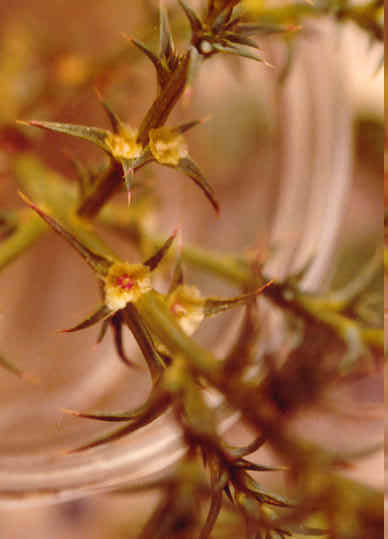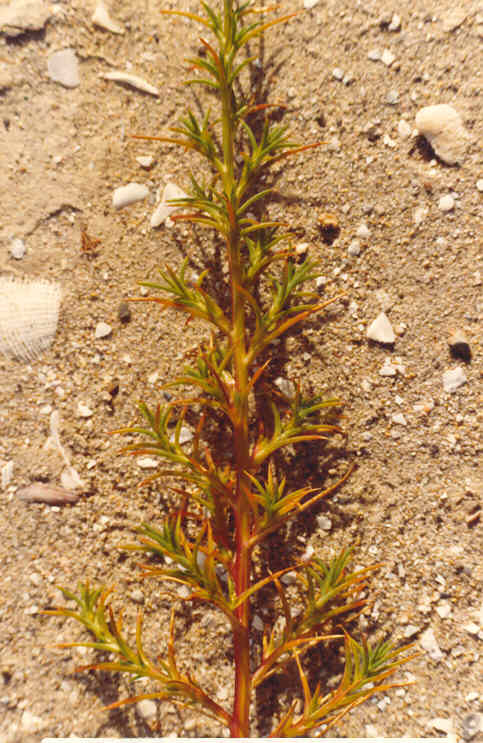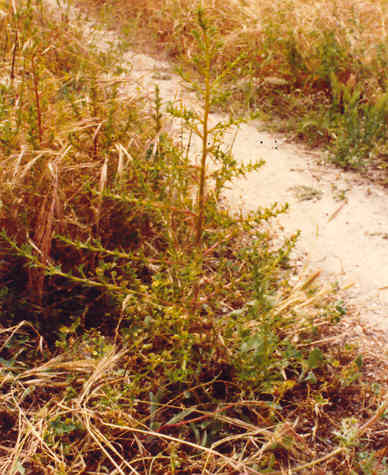
Salsola tragus L.
=Salsola australis
=S. iberica
= S. kali var. tenuifolia
Chenopodiaceae (Goosefoot Family)
Eurasia
Tumbleweed
Russian Thistle
 |
Salsola tragus L.=Salsola australis=S. iberica= S. kali var. tenuifoliaChenopodiaceae (Goosefoot Family)Eurasia
TumbleweedRussian Thistle
|
June Photo
Plant Characteristics:
Annual 3-10 dm. high, densely and intricately branched, forming a round
bushy clump, usually quite glabrous; lower leaves terete, fleshy, linear, 3-5
cm. long, pungent tipped; fls. perfect, small, solitary or fascicled, axillary,
bibracteolate; bracts ovate, short-acuminate, prickly-pointed, indurate in fr.;
fruiting calyx 3-6 mm. broad, the wings membranous, conspicuously veined, often
reddish; seed horizontal, orbicular, black, shining, 1.5-2 mm. broad; embryo
spirally coiled.
Habitat:
Common as a tumbleweed in cult. fields and open areas; many Plant
Communities through most of Calif. and w. N. Am. to Atlantic Coast. July-Oct.
Name:
Salsola is from Latin, salsus,
"salty". Iberica
indicates it might first have been described from a specimen collected in Spain.
(Dale 97). Australis,
southern. (Bailey 11).
Greek, tragus, a he-goat.
(Jaeger 269). May refer to
the fact that goats eat the young shoots. The
meaning of the word kali is not clear.
(my comments).
General:
Very common in the study area. Photographed
on the North Star Flats. (my comments).
Fifty years ago Russian observers reported stretches of this plant for
500 to 600 miles in the most fertile parts of their country and said that it had
driven every farmer out of the area. It
came to the United States in 1873 in imported flax seed sown in South Dakota.
It is a true "tumble weed" and has tumbled to California
prolifically. A single plant may
produce from 20,000 to 50,000 seeds and scatters them as it tumbles.
(Dale 97). In
Europe, the ashes of the plant were once used in the production of carbonate of
soda. Early shoots are good cooked
or chopped into salads. They have
excellent flavor and are related to spinach.
(Clarke 222-224).
Salsola species have been known to cause hay fever and asthma.
(Fuller 380). S.
australis has been known to accumulate free nitrates in quantities capable
of causing death or distress in cattle. (Fuller
385). About
50 species, widely dispersed. (Munz,
Flora So. Calif. 368).
S. australis, S. iberica,
S. kali var. tenuifolia all misapplied.
Noxious weed. S.
pestifer may be the valid name. (Hickman,
Ed. 514).
Text Ref:
Hickman, Ed. 514; Munz, Calif.
Flora 384; Munz, Flora So. Calif.
368; Roberts 19.
Photo Ref:
April 1 83 # 24; June 2 83 # 1; Oct-Nov 83 # 5.
Identity: by R. De Ruff,
confirmed by G. Marsh.
First Found: April 1983.
Computer Ref: Plant Data 228.
No plant specimen.
Last edit 3/4/05.
 |
 |